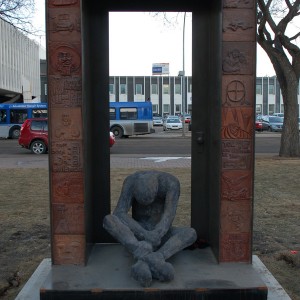Red
The Canadian premier of the play Red opened at the Citadel Theatre on February 4. Starring Jim Mezon (as Mark Rothko) and David Coomber (as Ken), it is a co-production between the Citadel Theatre, Canadian Stage, and the Vancouver Playhouse. It has previously played in London and New York to rave reviews, but under different direction.
This play is a bio-drama. Mark Rothko was an abstract expressionist painter at the height of his artistic career. It is set in 1958 in New York, the emerging heart of the Western art world. Abstract expressionism was the first truly international art movement to come out of the United States. Rothko is commissioned to create a series of murals for the new ultra modern Seagram Building in downtown New York.
Rothko’s artistic mission is to cause people to reflect on the deeper experiences of life, like the juxtaposition of beauty and tragedy, hope and despair. His murals are dominated by the colours red and black. Red symbolizes life, while black symbolizes a loss of hope and death. Rothko is obsessed with death. Through the dialogue, these murals become characters in the play – they are extensions of Rothko’s consciousness. To him, they are like offspring. He believes they can promote positive social change. The question, “What do you see?” both begins and ends this play. I think what Rothko means is, “What do you feel when you look at my art. Does it touch you deep within your psyche?”
This is a multi-layered screenplay, so I will focus only on two themes. The first is Rothko’s concern that he is selling out to the commercialization of art by taking this commission. Would his murals be able to fulfill their mission hanging on the walls of a bourgeoisie restaurant? Would anybody actually see and feel them? The second theme is Rothko’s distaste for and fear of the newly emerging pop art movement, most popularly represented by the work of Andy Warhol. To Rothko, pop art lacks meaning and is disposable. Rothko’s fear is that pop art will supplant his style of art, as abstract expressionism replaced cubism in an earlier generation.
The play has a painful but happy ending. Rothko chooses to preserve the integrity of his work at considerable financial cost. He also releases his assistant (Ken) to develop his skills within the pop art movement. However, the real Rothko’s life ends in tragedy. While he did eventually find an appropriate home for his murals, it appears that the black overcame the red in his life. In the gallery that now houses these murals, Rothko took his own life in 1970 at the age of 66. While somewhat over produced, you will feel the power of Rothko’s art. See it. The play runs until March 4.








